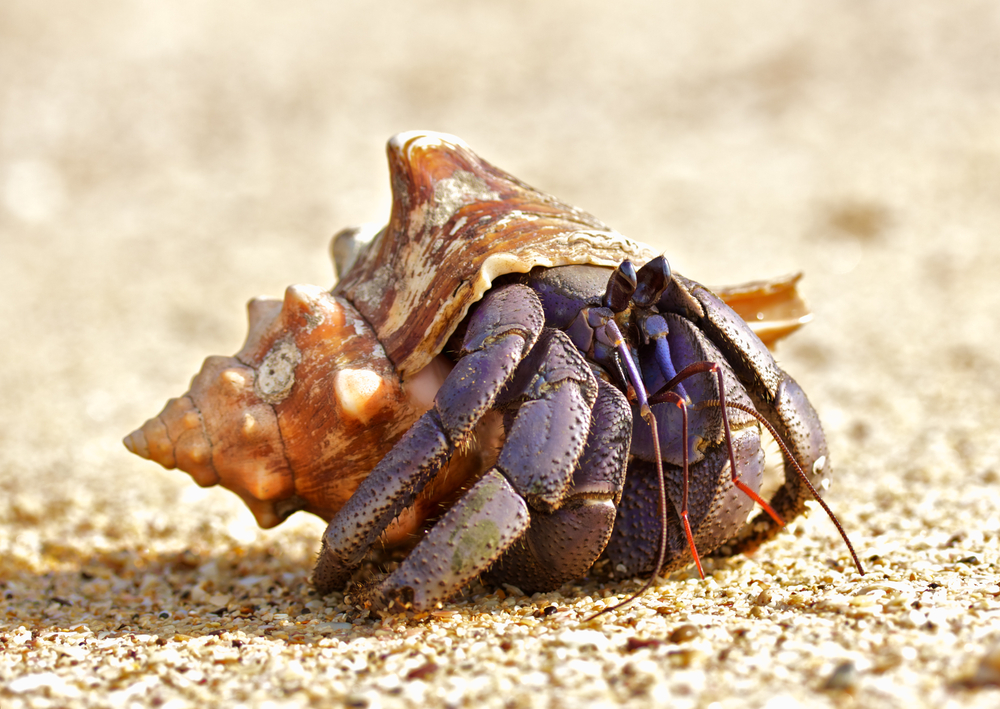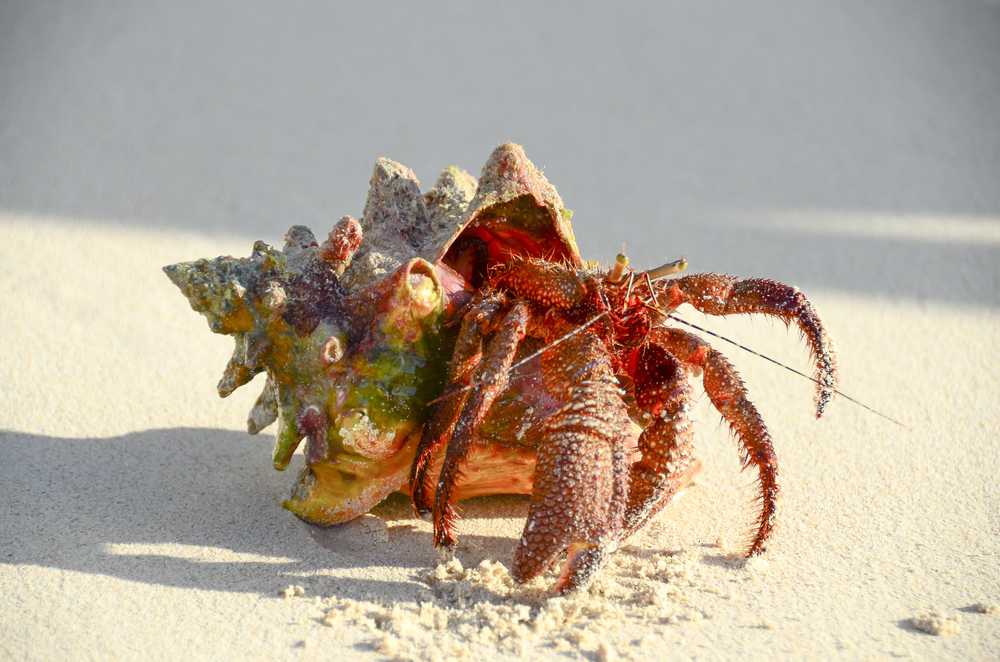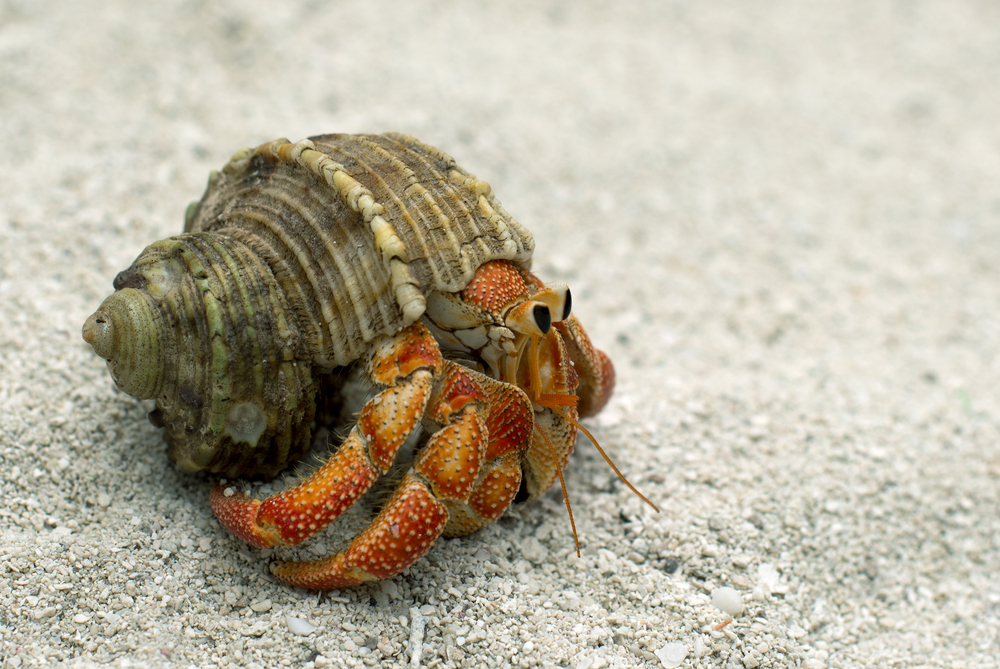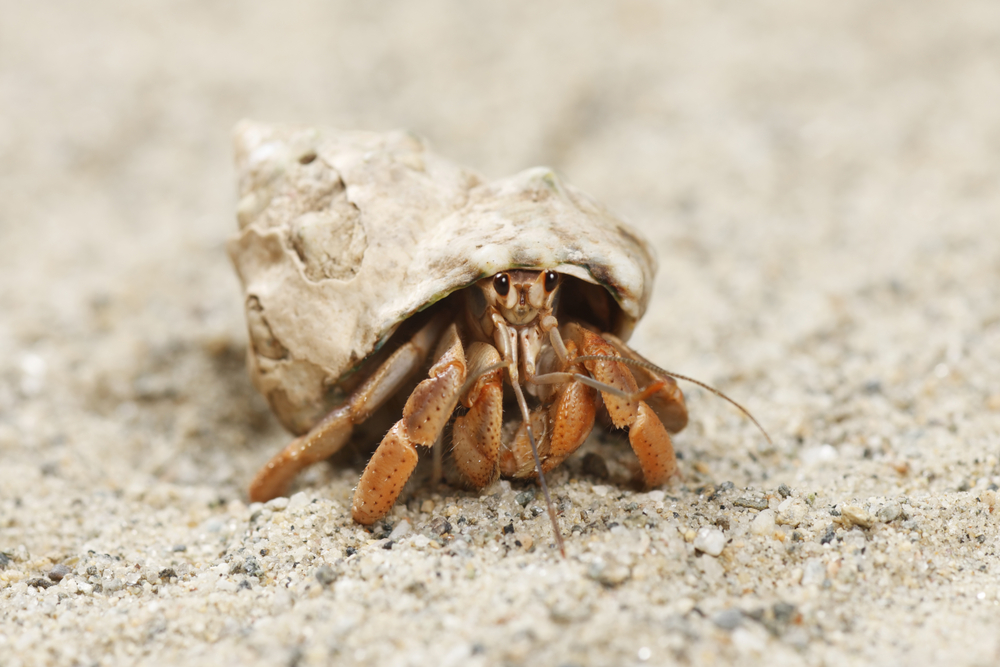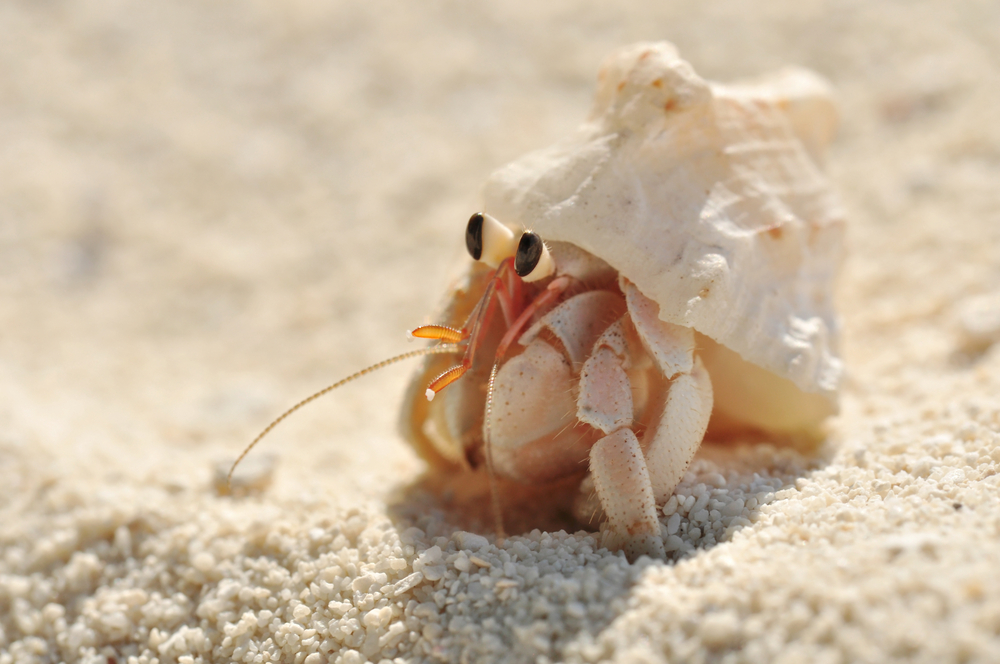About
The Hermit Crab, belonging to the superfamily Paguroidea, is a crustacean within the Animal Kingdom’s phylum Arthropoda and class Malacostraca. These fascinating creatures inhabit marine and terrestrial environments worldwide, residing in empty gastropod shells for protection.
Hermit crabs exhibit a unique behavior of carrying shells on their backs, which they use as mobile homes. As they grow, they must find larger shells to accommodate their increasing size. They are scavengers, feeding on a variety of organic matter such as algae, dead animals, and detritus, contributing to ecosystem nutrient cycling and decomposition processes.
Conservation Concerns
Hermit crabs are not directly assessed on the IUCN Red List. However, they face conservation concerns related to habitat degradation and pollution. Coastal development, habitat destruction, and marine pollution from debris and oil spills pose significant threats to hermit crab populations by reducing suitable habitat and food sources.
Furthermore, over-collection of shells for the shell trade can disrupt natural populations and habitat dynamics. To address these challenges, conservation efforts should focus on protecting coastal habitats, reducing pollution, and promoting sustainable harvesting practices. Public education and awareness campaigns are also crucial for fostering responsible stewardship of marine environments and ensuring the long-term survival of hermit crab populations.
Physical Characteristic
Hermit crabs are fascinating creatures known for their unique practice of living in discarded shells to protect their delicate abdomens. They belong to the superfamily Paguroidea and are not true crabs. Here’s a detailed description of the physical characteristics of hermit crabs, including measurements in both Imperial and Metric units:
Size
- Body Length: Hermit crabs can vary significantly in size depending on the species. Small species may measure just over 0.5 inches (about 1.3 centimeters) in length, while larger ones like the coconut crab (the largest terrestrial invertebrate) can reach up to 4 feet (1.2 meters) from leg to leg.
- Weight: The weight also varies widely. Smaller hermit crabs can weigh a few ounces (less than 100 grams), whereas the coconut crab can weigh up to 9 pounds (about 4 kilograms).
Physical Characteristics
- Exoskeleton: Like all crustaceans, hermit crabs have a hard exoskeleton that provides protection and support. However, their exoskeleton doesn’t cover their entire body, leaving their abdomen soft and vulnerable.
- Abdomen: Unlike true crabs, hermit crabs have a soft, asymmetrical abdomen that they coil into the spiral of a snail shell or similar object for protection.
- Claws: Hermit crabs have two main claws, one of which is typically larger and serves as the primary defense against predators and for manipulating objects. The larger claw can also seal the entrance to their shell when the crab retracts inside.
- Legs: They possess five pairs of legs, with the first pair being modified into claws. The three pairs of walking legs help the crab move, and the last pair, which is smaller and often hidden inside the shell, aids in holding onto the inside of the shell.
- Antennae: Hermit crabs have two pairs of antennae. The longer pair is used for sensing their environment, while the shorter pair is used primarily for tasting and smelling.
- Eyes: Positioned on stalks, their eyes are highly adapted for spotting predators and food. The stalks can move to help the crab see in different directions without having to move its body.
- Shell: While not a part of their body, the shell is a critical aspect of a hermit crab’s physical presence. They select and inhabit discarded gastropod shells (or other hollow objects, in captivity) to protect their vulnerable abdomen. As they grow, they must find larger shells to accommodate their increasing size.
Coloration
- Body Color: The coloration of hermit crabs can vary widely among species, ranging from red, brown, and orange to more muted tones. The color often helps with camouflage in their natural habitat.
- Shell: The appearance of the shell depends on the species of gastropod that originally created it. Hermit crabs may also decorate their shells with anemones, algae, or other materials as camouflage or protection.
Hermit crabs are known for their fascinating behavior of changing shells as they grow, a process that highlights their unique adaptability and the importance of shell availability in their habitats.
Reproduction
The reproductive cycle of the Hermit Crab is an intriguing process that varies among species but generally follows a similar pattern. Here’s an overview:
Mating Season: Hermit Crabs typically reproduce during specific seasons, although the timing can vary depending on the species and environmental conditions. Mating behavior often occurs during warmer months when water temperatures are favorable for reproduction.
Courtship and Mating: Male Hermit Crabs use chemical signals and visual displays to attract females for mating. Courtship rituals may involve intricate behaviors such as antennae waving, shell inspection, and claw displays. Once a receptive female is found, mating occurs through the transfer of sperm from the male to the female.
Egg Development: After mating, female Hermit Crabs carry fertilized eggs internally until they mature. The duration of egg development can vary but generally ranges from a few weeks to several months, depending on factors like temperature and species.
Egg Laying: Once the eggs are fully developed, female Hermit Crabs seek out suitable locations to lay their eggs. This often involves burrowing into the sand or finding protected areas among rocks or vegetation. The female deposits the eggs in a cluster and attaches them to her abdomen using specialized appendages called pleopods.
Incubation Period: During the incubation period, the female Hermit Crab carefully guards her eggs, ensuring they receive adequate oxygen and protection from predators. The duration of incubation varies depending on environmental conditions and species but can last several weeks to months.
Hatching and Larval Stage: When the eggs hatch, tiny larvae emerge from their egg casings and enter the water. These larvae undergo a planktonic stage, drifting with ocean currents and feeding on microscopic organisms. Over time, they undergo a series of molts and develop into juvenile Hermit Crabs.
Juvenile and Adult Stage: After completing their larval stage, young Hermit Crabs settle on the ocean floor or nearshore habitats, where they begin their transition to adulthood. As they grow, they inhabit empty gastropod shells for protection, gradually increasing in size and eventually reaching reproductive maturity.
Reproductive Success and Population Dynamics: The reproductive success of Hermit Crabs depends on various factors, including habitat availability, food resources, and environmental conditions. Population dynamics are influenced by factors such as predation, competition, and human activities, highlighting the importance of habitat conservation and sustainable management practices for maintaining healthy Hermit Crab populations.
Lifespan
Hermit crabs are small crustaceans belonging to the superfamily Paguroidea. They are widely distributed across tropical and subtropical regions of the world’s oceans and are known for their unique habit of using empty shells as portable shelters. Hermit crabs play essential roles in marine ecosystems as scavengers and detrivores. Here’s an overview of their lifespan and the threats they face:
Lifespan in the Wild: In the wild, the lifespan of hermit crabs varies depending on species, environmental conditions, and predation. On average, hermit crabs can live for several years, with some species reaching ages of 10 years or more under favorable conditions. However, many factors, including habitat quality, food availability, and interactions with predators and competitors, can influence their lifespan in the wild.
Lifespan in Captivity: Hermit crabs can also be kept as pets in captivity, where they may have access to stable environmental conditions, consistent food sources, and protection from natural predators. In captivity, hermit crabs can live for several years, with some individuals reaching ages beyond their wild counterparts. Proper care, including maintaining suitable temperature, humidity, and substrate, and providing adequate nutrition, is essential for ensuring the well-being and longevity of hermit crabs in captivity.
Threats to the Hermit Crab:
- Habitat Destruction: Habitat destruction, including coastal development, pollution, and habitat degradation, threatens the survival of hermit crabs by reducing the availability of suitable habitats and food resources. Loss of mangroves, coral reefs, and intertidal zones due to human activities can disrupt the natural ecosystems where hermit crabs reside.
- Predation: Hermit crabs are preyed upon by various predators, including birds, fish, crustaceans, and mammals. Predation pressure can be particularly high for juvenile hermit crabs, which are vulnerable due to their small size and soft exoskeletons. Loss of natural predators or introduction of non-native predators can disrupt predator-prey dynamics and impact hermit crab populations.
- Overcollection: Hermit crabs are sometimes collected from the wild for the pet trade or for use as bait in fishing. Overcollection can deplete local populations and disrupt ecological balances, especially if collection rates exceed natural reproduction rates. Sustainable harvesting practices and regulations are necessary to prevent overexploitation of hermit crab populations.
- Climate Change: Climate change poses significant threats to hermit crabs and their habitats. Rising sea levels, ocean acidification, and increasing temperatures can alter coastal ecosystems, affecting the distribution and abundance of hermit crab species. Changes in temperature and ocean chemistry can also impact the availability of calcium carbonate shells, which hermit crabs rely on for shelter.
- Pollution: Pollution from urban runoff, agricultural runoff, oil spills, and marine debris can contaminate coastal habitats and harm hermit crabs. Chemical pollutants, plastics, and other debris can be ingested by hermit crabs or become entangled in their shells, leading to physical harm, poisoning, or suffocation.
Conservation efforts aimed at protecting hermit crabs include preserving coastal habitats, implementing sustainable harvesting practices, reducing pollution and habitat degradation, and raising awareness about the importance of conserving marine ecosystems and biodiversity. By addressing these threats and implementing comprehensive conservation measures, it is possible to safeguard the long-term survival of hermit crabs and their habitats.
Eating Habits
The hermit crab is a fascinating crustacean known for its unique behavior of adopting empty shells as protective homes. Understanding its eating habits sheds light on its role as a scavenger and detritivore in coastal ecosystems. Let’s explore the feeding habits of the hermit crab.
Diet: Hermit crabs are omnivorous scavengers, feeding on a diverse array of organic matter. Their diet typically includes:
- Detritus: Hermit crabs primarily feed on decaying plant and animal matter, commonly referred to as detritus. They play a vital role in breaking down dead organic material, contributing to nutrient recycling in their habitat.
- Algae: Some hermit crab species graze on algae growing on rocks and submerged surfaces. Algae provide a source of nutrients and may contribute to the crab’s diet, especially in areas where it is abundant.
- Small Invertebrates: In addition to detritus, hermit crabs may consume small invertebrates such as mollusks, worms, and small crustaceans. They scavenge for these prey items among rocks, sand, and debris on the seafloor.
Feeding Behavior: Hermit crabs exhibit several feeding behaviors to obtain their food:
- Scavenging: They actively search for and consume organic matter found on the seafloor, including dead plants, animals, and carrion. Their scavenging behavior helps to clean up and recycle nutrients in their environment.
- Filter Feeding: Some hermit crab species have specialized appendages called maxillipeds, which they use to filter small particles and plankton from the water column. This feeding strategy allows them to capture suspended food particles and planktonic organisms.
- Grazing: In areas with abundant algae growth, hermit crabs may graze on algae-covered surfaces, using their specialized mouthparts to scrape off and consume the algae.
Dietary Adaptations:
- Hermit crabs have specialized mouthparts, including mandibles and maxillipeds, adapted for chewing and processing a variety of food types.
- Their scavenging behavior and ability to consume detritus contribute to nutrient cycling and ecosystem health in coastal habitats.
Conservation Concerns:
- Pollution and habitat degradation pose significant threats to hermit crab populations. Contaminants such as oil spills and chemical pollutants can negatively impact water quality and disrupt their food sources.
- Coastal development and habitat destruction can lead to the loss of essential feeding grounds for hermit crabs, affecting their ability to find food and survive in their environment. Conservation efforts focused on preserving coastal habitats are essential for protecting hermit crab populations.
Uniqueness
The Hermit Crab, belonging to the superfamily Paguroidea, is an intriguing creature known for its distinctive habit of living in borrowed shells. This unique adaptation makes it different from other crustaceans. Here are some key aspects that make the Hermit Crab unique:
Shell Utilization: Unlike other crabs that have hard exoskeletons covering their entire bodies, Hermit Crabs have soft, vulnerable abdomens. To protect themselves, they use discarded shells from other marine creatures, such as snails. As they grow, they must find larger shells and often engage in shell-swapping behaviors with other hermit crabs.
Diverse Species: There are over 800 species of Hermit Crabs, and they are found in varying habitats around the world, from deep-sea environments to shorelines and even on land, particularly in tropical regions. Each species has adapted to its specific environment, though all share the common trait of using a shell for protection.
Social Behavior: Hermit Crabs are known for their surprisingly social behavior. They can often be found living in groups, and they engage in complex social interactions, including cooperative behaviors such as forming “vacancy chains” where multiple hermits queue up for a shell exchange as a larger shell becomes available.
Reproduction: Female hermit crabs carry fertilized eggs in their shells until they are ready to hatch. The larvae are released into the water and go through several planktonic stages before settling down and finding a small shell to inhabit.
Diet and Foraging: Hermit Crabs are scavengers, primarily feeding on a wide variety of organic materials, including decomposing plant and animal matter. Their diet makes them important cleaners in their ecosystems, helping to recycle nutrients back into the environment.
Respiration: Terrestrial hermit crabs have modified gills that allow them to breathe air, but they must keep these gills moist to absorb oxygen. This necessity influences their behavior, requiring them to return to the water periodically or live in humid environments.
Sensory Abilities: Hermit Crabs have a keen sense of smell, which is essential for finding food and navigating their environment. They also use their antennae for touch and taste, helping them explore and interact with their surroundings.
Conservation Status: While not typically considered endangered, some terrestrial species of hermit crabs face threats from habitat loss and the pet trade. The collection of shells by tourists can also reduce the availability of essential resources (shells) necessary for their survival.
Hermit Crabs’ unique use of shells for protection and their complex social behaviors make them fascinating subjects of study in marine biology and ecology. Their ability to adapt to both marine and terrestrial environments, along with their role in the nutrient cycle, underscores their importance in diverse ecosystems.
Related Family Species
Sources
- Burnie, David & Wilson, Don, Animal, Smithsonian Institute, Washington DC.
- Hickman et al, Integrated Principle of Zoology, McGraw Hill, Boston.






























































